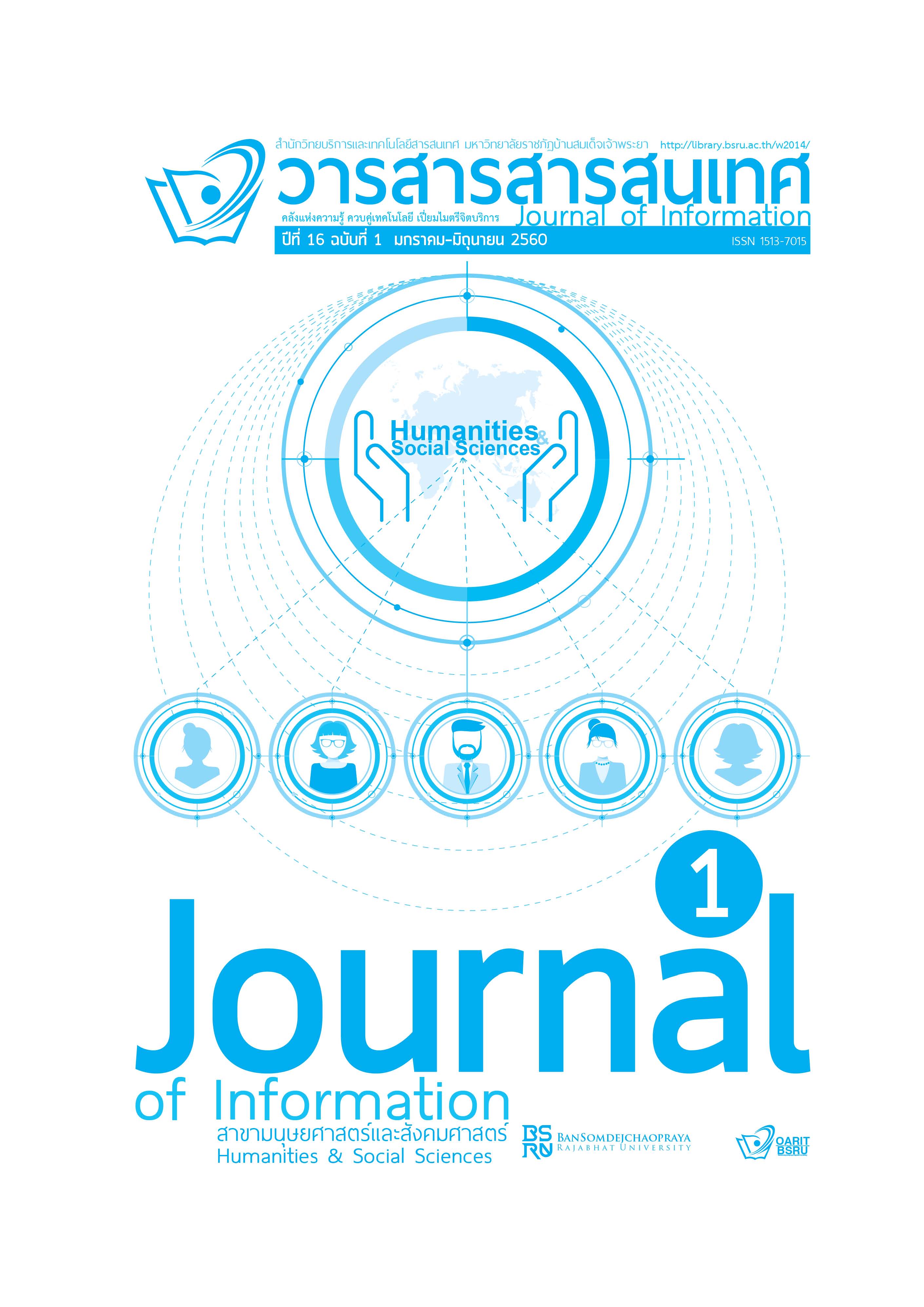การพัฒนารูปแบบการจัดการเรียนรู้ด้านการตลาดเพื่อส่งเสริมธุรกิจชุมชน : กรณีศึกษาธุรกิจเครื่องปั้นดินเผาชุมชนเกาะเกร็ด The Development of Marketing Learning Management Model to Encourage the Community Business : A Case Study of Clay Pottery Business in KohKr
Keywords:
รูปแบบการจัดการเรียนรู้, ธุรกิจชุมชน, เครื่องปั้นดินเผาเกาะเกร็ด, Learning Management Model, Community Business, Clay Pottery in KohKretAbstract
บทคัดย่อ
การวิจัยนี้มีวัตถุประสงค์เพื่อพัฒนารูปแบบการจัดการเรียนรู้ด้านการตลาดเพื่อส่งเสริมธุรกิจเครื่องปั้นดินเผาชุมชนเกาะเกร็ด เป็นการวิจัยและพัฒนา (R&D) โดยขั้นตอนใช้การวิจัยเชิงสำรวจ และเชิงคุณภาพ กลุ่มตัวอย่างที่ใช้ในการวิจัยมี 2 กลุ่มคือ กลุ่มผู้ประกอบการธุรกิจเครื่องปั้นดินเผาชุมชนเกาะเกร็ด จำนวน 30 ราย และกลุ่มลูกค้าที่มาท่องเที่ยวเกาะเกร็ดจำนวน 400 ราย เครื่องมือที่ใช้ในการวิจัยมี 8 ชนิด คือ 1) แบบวัดความต้องการของลูกค้า 2) แบบสัมภาษณ์เชิงลึก 3) แผนการอบรม 4) แบบวัดระดับการดำเนินการทางการตลาด 5) แบบวัดความรู้ด้านการตลาด 6) แบบวัดระดับการเรียนรู้การอบรม 7) แบบวัดความพึงพอใจของลูกค้า 8) แบบวัดรายได้ของกิจการ สถิติที่ใช้ในการวิเคราะห์ข้อมูลคือ ค่าร้อยละ ค่าเฉลี่ย ส่วนเบี่ยงเบนมาตรฐานการทดสอบสมมติฐานของกลุ่มตัวอย่าง 2 กลุ่มการวิเคราะห์สหสัมพันธ์แบบถดถอย และการวิเคราะห์ข้อมูลเชิงเนื้อหา
ผลการวิจัยพบว่า ความต้องการของลูกค้าที่มีผลต่อการกำหนดส่วนประสมการตลาดโดยรวม อยู่ในระดับปานกลาง โดยลูกค้าให้ความสำคัญปัจจัยด้านการส่งเสริมการตลาดมากที่สุดซึ่งสมการพยากรณ์องค์ประกอบของปัจจัยส่วนประสมการตลาดที่ส่งผลต่อการตัดสินใจซื้อเครื่องปั้นดินเผาชุมชนเกาะเกร็ดในรูปของคะแนนดิบ คือ
y^ =1.060 + 0.358 (x1) + 0.218 (x2) + 0.150 (x3)+ 0.376 (x)
ตัวพยากรณ์ทั้ง 4 ตัว ประกอบด้วยผลิตภัณฑ์ (x1)ราคา (x2) การจัดจำหน่าย(x3)และการส่งเสริมการตลาด (x4)มีความสัมพันธ์กับอิทธิพลของส่วนประสมการตลาดที่ส่งผลต่อการตัดสินใจซื้อเครื่องปั้นดินเผาชุมชนเกาะเกร็ด เท่ากับ 0.770 โดยตัวแปรทั้ง 4 ตัว มีอำนาจพยากรณ์ค่าอิทธิพลของส่วนประสมการตลาดร่วมกันได้ร้อยละ 59.40 โดยตัวพยากรณ์ที่มีอิทธิพลส่งผลต่อการตัดสินใจซื้อมากที่สุด ได้แก่ ปัจจัยด้านการส่งเสริมการตลาด และปัจจัยด้านผลิตภัณฑ์ อย่างมีนัยสำคัญทางสถิติที่ระดับ 0.01 ในด้านผู้ประกอบการได้ให้ระดับการดำเนินการทางการตลาดต่อการกำหนดส่วนประสมการตลาดโดยรวมอยู่ในระดับน้อย โดยผู้ประกอบการให้ความสำคัญปัจจัยด้านผลิตภัณฑ์มากที่สุด รองลงมาคือปัจจัยด้านราคาผลการประเมินภายหลังการอบรม พบว่าระดับการดำเนินการทางการตลาด ความรู้ด้านการตลาด และระดับการเรียนรู้ของผู้ประกอบการก่อนและหลังการอบรมแตกต่างกันอย่างมีนัยสำคัญทางสถิติที่ระดับ 0.05 กล่าวคือ ระดับค่าเฉลี่ยของคะแนนภายหลังการอบรมเพิ่มขึ้นเมื่อเปรียบเทียบกับระดับค่าเฉลี่ยของคะแนนก่อนการอบรม ผลการประเมินความสำเร็จของธุรกิจจากการวัด 2 ด้าน คือ 1)การวัดความพึงพอใจของลูกค้า พบว่า ความพึงพอใจของลูกค้าที่มีผลต่อการกำหนดส่วนประสมการตลาดในมุมมองลูกค้า โดยรวมอยู่ในระดับมาก โดยลูกค้าให้ความสำคัญปัจจัยด้านการตอบสนองความต้องการ 2)การวัดรายได้ของกิจการ พบว่า ผู้ประกอบการมีรายได้เฉลี่ยต่อเดือนเพิ่มมากขึ้นภายหลังการนำความรู้ที่อบรมไปใช้ดำเนินธุรกิจ โดยรายได้เฉลี่ยเปรียบเทียบระหว่างเดือนที่ 1 และเดือนที่ 6 เพิ่มขึ้น 17,565 บาท คิดเป็นร้อยละ 39.68 ผลการวิเคราะห์ข้อมูลแต่ละส่วน พบว่ารูปแบบการจัดการเรียนรู้ด้านการตลาดเพื่อส่งเสริมธุรกิจเครื่องปั้นดินเผาชุมชนเกาะเกร็ด ประกอบด้วย 4 องค์ประกอบ คือ 1)การวิเคราะห์สภาพแวดล้อม เป็นขั้นตอนที่ทำให้ทราบศักยภาพของธุรกิจ 2)การกำหนดตลาดเป้าหมาย เป็นการเลือกตลาดเป้าหมายและจุดเด่นของธุรกิจ 3)การดำเนินการจัดการเรียนรู้ด้านการตลาด โดยแบ่งออกเป็น 4 ขั้น ได้แก่ การสร้างแผนการอบรมเพื่อการจัดการเรียนรู้ด้านการตลาด การวัดผล 3 ด้านก่อนการอบรม การจัดการเรียนรู้ด้านการตลาดด้วยวิธีการอบรมการวัดผล 3 ด้านหลังการอบรม 4)การประเมินผลสำเร็จของธุรกิจเป็นการประเมินความพึงพอใจของลูกค้าและรายได้ของกิจการ
Abstract
The aim of this research was to develop the model of marketing learning management to encourage the clay pottery business in KohKret community. It was Research and Development using the procedure of surveying and qualitative approach. The data were collected from two sample groups. The first group was collected from the entrepreneurs who conducted the clay pottery business in KohKret community with the size of 30 and the second group was collected from 400 tourists who visited KohKret. Tools used in the research were classified into eight categories as follows: 1) Customer’s demand survey 2) Depth interview 3) Training plans 4) Level of marketing operation survey 5) Level of marketing base knowledge survey 6) Level of training base knowledge survey 7) Customer satisfaction survey 8) The income from the business survey were administered to collect the data which, in turn, were analyzed by using percentage, mean, standard deviation, the analysis of correlation of two sample groups, regression analysis as well as content analysis.
The research result revealed that theoverall customer demand in marketing mix was in moderate level. Customers gave the most concentrate in promotion. The forecast equation of marketing mix factors that affected the customer’s decision to buy clay pottery in KohKret, in the form of raw score was:
Y^ =1.060 + 0.358 (x1) + 0.218 (x2) + 0.150 (x3)+ 0.376 (x)
The four variables were Product (x1), Price (x2), Place (x3), and Promotion (x4) which were related to the marketing mix that affected the customer’s decision to buy clay pottery in KohKret by 0.770. The four variables had the value of marketing mix factors that affected the customer’s decision to buy clay pottery in KohKret of 59.40 percent. The variable that affected the customer’s decision the most were promotion and product with a standard deviation of 0.01. Entrepreneur had determined the level of market act by overall marketing mix as low level. Entrepreneur gave the most concentrate in product, followed by price. The results after the training session showed that the level of marketing act, knowledge, and learning levels of entrepreneur, before and after the training had a standard deviation of 0.05. This can be concluded that the score increased after the training. The success of the business was measured by these two aspects: 1) The measurement of customer’s satisfaction, which found that customer satisfaction affects the overall customer’s view in marketing mix with high level. Customers were interested in response needs 2) The measurement of income of entrepreneur showed that average income per month increased after the training. By comparison, the average income between first month and sixth month increased by 17,565baht or 39.68percent. The analysis showed that the model of marketing learning management to encourage the clay pottery business in KohKret community consisted of four components: 1) An environment analysis step by step for showing the potential of the business 2) Market targeting was a selection of market and advantage of the business 3) The operation of marketing learning was divided into four stages, which were the building training plan for marketing learning management by evaluating of three aspects before the training marketing learning management by training and evaluating of three aspects after the training. 4) The evaluation of business succession was the determination of customer satisfaction and business income.
Downloads
Published
How to Cite
Issue
Section
License
บทความ ข้อความ ภาพประกอบ และตารางประกอบที่ลงพิมพ์ในวารสารเป็นความคิดเห็นส่วนตัวของผู้นิพนธ์ กองบรรณาธิการไม่จำเป็นต้องเห็นตามเสมอไป และไม่มีส่วนรับผิดชอบใดๆ ถือเป็นความรับผิดชอบของผู้นิพนธ์เพียงผู้เดียว






